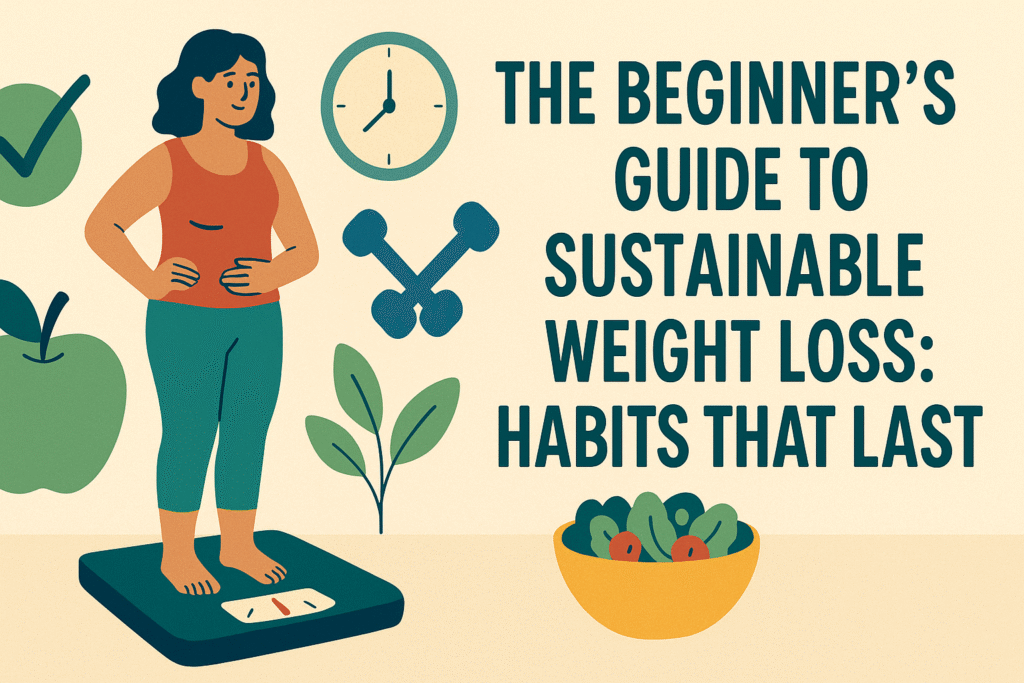If you’re just starting a weight-loss journey, the most important thing to learn early is that sustainable results come from building habits you can keep for life — not from short-term restrictions or extreme routines. This guide breaks down practical, evidence-based habits that help you lose weight in a healthy, maintainable way.
Start with mindset and realistic goals
– Aim for progress, not perfection. Small consistent changes add up; a 1% improvement each week compounds quickly.
– Set SMART goals (Specific, Measurable, Achievable, Relevant, Time-bound). Example: “Lose 4–6 pounds in 8–12 weeks by walking 30 minutes five times a week and reducing fast-food meals to one per week.”
– Expect non-linear progress. Plateaus and setbacks are normal. Learn from them and adjust rather than quit.
Make small, sustainable nutritional changes
– Create a modest calorie gap. A safe, sustainable rate of loss is about 0.5–1 pound (≈0.25–0.5 kg) per week for most people. That usually requires a daily deficit around 250–500 calories. Extreme cuts are hard to maintain and can cause muscle loss or metabolic slowdown.
– Focus on whole foods: vegetables, fruits, lean proteins, whole grains, legumes, nuts, and healthy fats. These fill you up with fewer calories and provide nutrients.
– Prioritize protein. Higher-protein meals help preserve muscle mass and increase satiety. Aim to include a source of protein at each meal (eggs, yogurt, chicken, beans, tofu, fish).
– Fiber matters. Vegetables, fruits, whole grains, and legumes slow digestion and reduce hunger.
– Reduce liquid calories. Soda, sweetened coffee drinks, and many juices add substantial calories without filling you.
– Use simple portion control strategies: smaller plates, pre-portion snacks, and being mindful of restaurant servings (split meals or take half home).
– Allow flexibility. Include foods you enjoy in reasonable amounts. All-or-nothing rules often trigger bingeing or abandonment.
Move more strategically

– Combine cardio and strength training. Aerobic activity (walking, cycling, swimming) burns calories, while resistance training preserves or builds muscle, which helps long-term metabolism.
– Start small and progress. If new to exercise, 10–20 minutes of brisk walking most days is a great start. Aim to work up to at least 150 minutes of moderate-intensity aerobic activity per week plus two sessions of strength training.
– Make physical activity part of daily life: take stairs, walk during breaks, bike for short trips.
– Consistency beats intensity at first. It’s better to be active most days for 20–30 minutes than sporadically to extremes.
Build non-diet habits that support weight loss
– Prioritize sleep. Aim for 7–9 hours per night. Poor sleep increases hunger hormones and cravings.
– Manage stress. Chronic stress raises cortisol, which may affect appetite and fat storage. Use techniques that work for you: breathing, walks, hobbies, social time, or professional help.
– Plan and prep. Meal planning, grocery lists, and prepping components (chopped veggies, cooked grains, portable snacks) make healthier choices more likely.
– Practice mindful eating: eat without distractions, chew slowly, and pause halfway through a meal to assess fullness.
Track what matters — without obsession
– Use simple tracking to learn patterns: a short food log for a week, activity minutes, sleep hours, or weekly weight check-ins. Tracking increases awareness and accountability.
– Avoid compulsive daily weighing if it harms your mood. Weekly weigh-ins, taken at the same time under similar conditions, give a clearer picture.
– Focus on non-scale wins too: better sleep, stronger workouts, clothes fitting differently, or improved energy.
Change your environment to reduce friction

– Make healthy choices convenient and visible: keep fruits and cut veggies accessible, stash water at your desk, and remove or hide tempting packaged foods.
– If others in your household have different habits, find compromises (e.g., keep shared treats out of sight, store them in a top cabinet).
Recognize common pitfalls and how to handle them
– All-or-nothing thinking: If you have an off day, get back to your routine the next meal rather than abandoning efforts.
– Undereating and overexercising: These may produce short-term weight loss but are hard to sustain and risk muscle loss and injury.
– Relying on willpower alone: Modify your environment, plan ahead, and automate decisions.
– Comparing to others: Everyone’s body and circumstances differ. Use others for inspiration, not as a strict benchmark.
Practical daily habit checklist (example)
– Breakfast with protein (e.g., Greek yogurt + berries or eggs + whole-grain toast)
– Move: 20–30 minutes of brisk walking or active breaks
– Include a veggie at lunch and dinner
– Drink water regularly; limit sugary drinks
– Strength session twice weekly (20–40 minutes)
– Sleep schedule: consistent bedtime and wake time

– Weekly meal prep or plan session (30–60 minutes)
– One non-scale win noted (energy level, clothes fit, mood)
Maintain motivation and plan for the long term
– Reassess goals periodically. Once you reach a goal, set a new maintenance or performance goal (e.g., maintain weight, improve run time, increase strength).
– Transition to a maintenance calorie level slowly and monitor weight for a few weeks, adjusting intake or activity to stabilize.
– Build habits around identity: instead of “I’m trying to lose weight,” think “I am someone who moves regularly and eats mindfully.”
– Expect seasonal and life-phase changes. Adapt your habits rather than abandoning them.
When to seek professional help
– If you have significant medical conditions (diabetes, heart disease, thyroid issues) or are on medications affecting weight, consult your healthcare provider before making major changes.
– Consider a registered dietitian for personalized nutrition plans or a certified trainer for safe exercise programming.
– Seek help if disordered eating patterns or emotional eating significantly interfere with daily life.
Final thoughts
Sustainable weight loss is less about a dramatic transformation and more about consistency, patience, and building an environment that supports healthier choices. Focus on small, evidence-based habits you can maintain, celebrate non-scale progress, and adjust as you learn what works best for your body and lifestyle.

